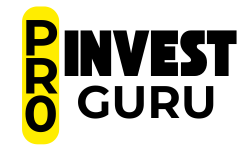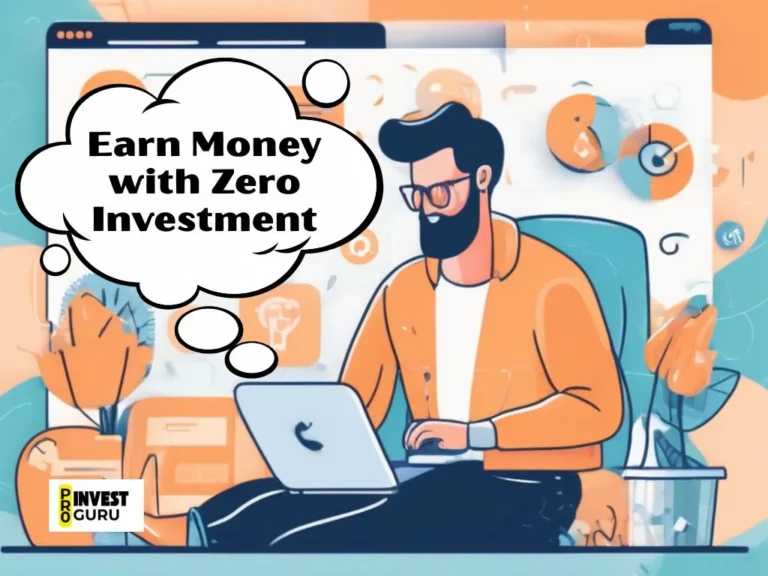How to Make Your First $500 Online as a Complete Beginner
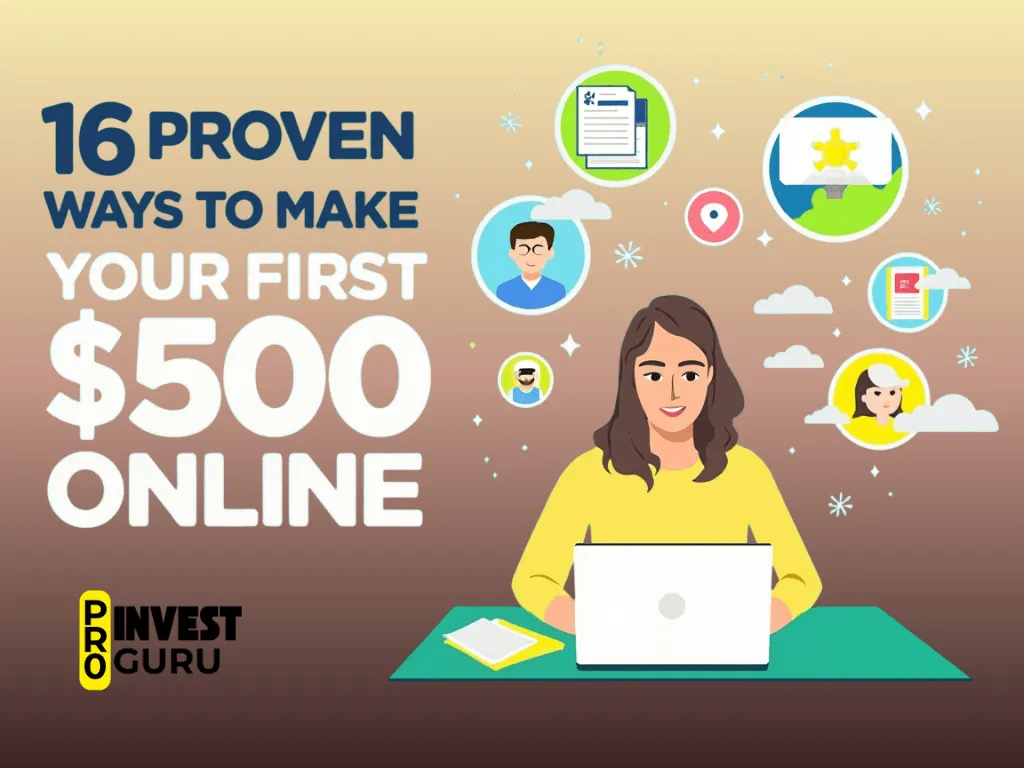
Let’s be honest: $500 might not sound life-changing, but for many households it can cover rent, groceries, or an emergency bill. According to a 2024 study by Empower, 37% of Americans cannot afford a $400 emergency expense. That shows just how important extra income streams are.
The good news? Earning $500 online is not only achievable it’s realistic for complete beginners with the right guidance. You don’t need a degree, massive investments, or years of experience. All you need is time, focus, and a clear roadmap.
We gives you that roadmap. From freelancing to surveys, from digital products to virtual assistance, you’ll learn the most practical and proven methods to hit your first $500 milestone.
Key Takeaways
- There are 16+ beginner-friendly methods to make money online.
- Some methods pay instantly (freelancing, surveys), while others grow with time (blogging, digital products).
- Most require little to no upfront investment.
- $500 is just the first milestone—many of these methods can scale into thousands per month.
Understanding the Digital Income Landscape
Before jumping into methods, it’s important to understand the world you’re stepping into.
The digital economy is worth trillions globally, and it’s expanding every year. Freelance platforms, gig work, e-commerce, and online education have lowered the barrier of entry. Anyone with an internet connection and a laptop can participate.
Why this matters:
- You’re no longer limited to local jobs—you can serve clients worldwide.
- Online work is flexible: you can work from home, at night, or even while traveling.
- The demand for remote services, digital products, and content creation is rising every single year.

Quick stats:
- 1 in 3 U.S. workers is now freelancing in some form.
- The global e-learning industry will be worth $319 billion by 2029.
- Digital side hustles like POD (Print on Demand) and social media income are creating thousands of new entrepreneurs monthly.
Essential Tools & Resources to Begin
Just like a carpenter needs a hammer, an online earner needs the right digital tools. Here’s your starter kit:
- Laptop/Smartphone: Nothing fancy required—just reliable.
- Stable Internet Connection: Non-negotiable.
- Professional Email & Payment Gateway: Gmail, PayPal, Wise, or Payoneer.
- Website/Portfolio (Optional but Powerful): Wix, WordPress, or Carrd for simple one-page portfolios.
- Social Media Presence: LinkedIn (for clients), Instagram/TikTok (for content/product promotion).
Pro Tip: Start small. A free Canva account + LinkedIn profile + PayPal account is enough for your first $500.
Developing the Right Mindset
Most beginners fail not because methods don’t work, but because they quit too soon. Making $500 online requires:
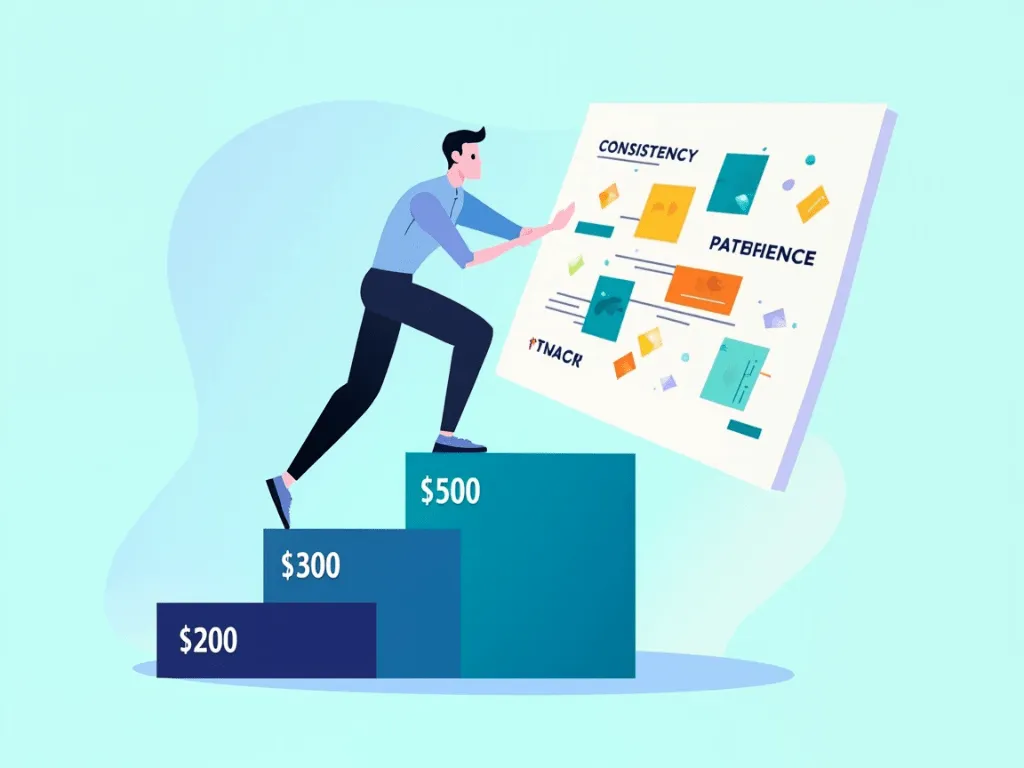
- Consistency: Work at least 1–2 hours daily.
- Patience: First client or sale may take weeks.
- Learning: Every rejection is feedback.
Mindset practices:
- Create a vision board (put $500 as your first milestone).
- Use affirmations like “I am building financial freedom online.”
- Break down goals into mini-steps ($100 → $250 → $500).
16 Best Ways to Make Your First $500 Online
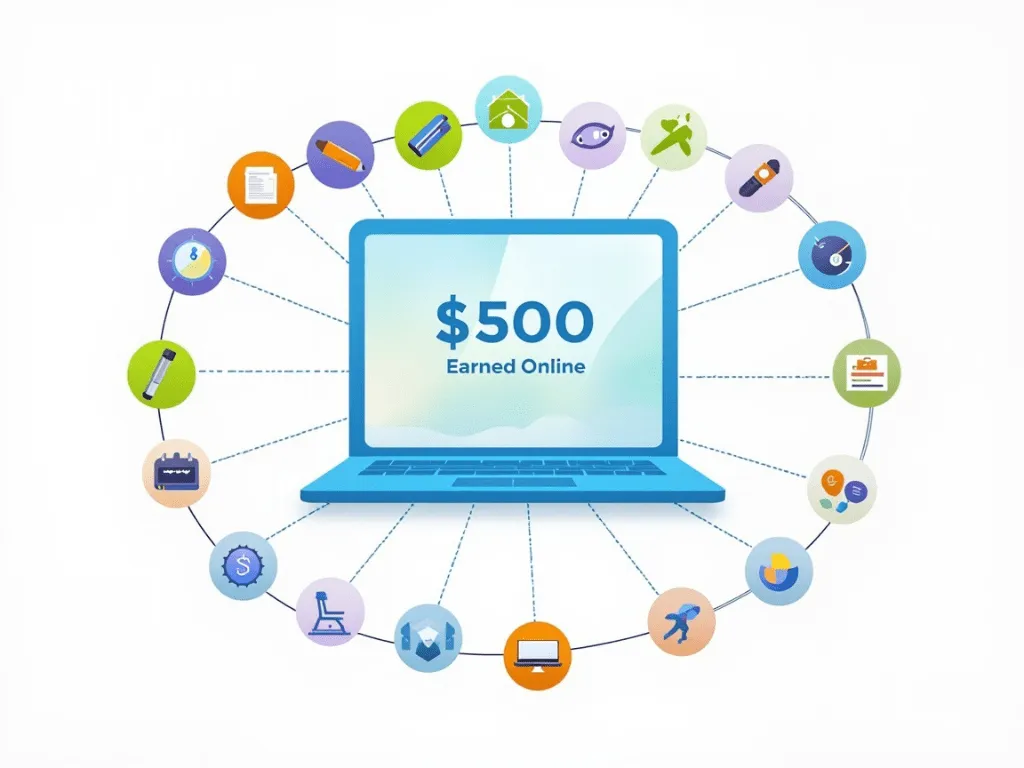
1. Freelancing
What it is:
Freelancing is selling your skills (writing, design, coding, video editing, etc.) to clients online.
How to start:
- Choose a skill you’re good at (or learn one via YouTube/Udemy).
- Create a profile on Upwork, Fiverr, or Freelancer.
- Build a portfolio with 2–3 sample works.
- Pitch clients consistently (5–10 proposals daily).
Earning potential: $15–$50/hour depending on skill. Beginners can reach $500 within 1–2 months.
Pros: Flexible, high demand, scalable.
Cons: Competitive, takes time to land first client.
Takeaway: The most reliable method for beginners to earn consistent online income.
2. Online Surveys & Microtasks
What it is:
Companies pay for user feedback and small online tasks.
How to start:
- Join Swagbucks, InboxDollars, Amazon Mechanical Turk.
- Complete surveys, watch ads, or perform microtasks like data entry.
Earning potential: $1–$5 per survey, $100–$300/month with consistency.
Pros: Easy, no skill required.
Cons: Low pay per hour.
Takeaway: Good for pocket money, but not sustainable long-term.
3. Selling Digital Products
What it is:
You create downloadable products (ebooks, templates, planners) and sell them repeatedly.
How to start:
- Design products using Canva.
- Upload to Gumroad, Payhip, or Etsy.
- Promote via Pinterest and Instagram.
Earning potential: $5–$20 per product; 50 sales of $10 = $500.
Pros: Passive, scalable, low startup cost.
Cons: Marketing effort required.
Takeaway: Best for creative beginners looking for passive income.
4. Virtual Assistance
What it is:
Virtual Assistants (VAs) help businesses with admin tasks like email management, scheduling, or customer support.
How to start:
- Learn basic tools (Google Docs, Trello, Zoom).
- Offer services on Upwork, Fiverr, or VA Facebook groups.
- Charge $10–$25/hour.
Earning potential: $300–$1,000/month part-time.
Pros: Repeat clients, flexible hours.
Cons: Can be time-bound.
Takeaway: A great entry-level service business requiring basic skills only.
5. Affiliate Marketing
What it is:
Promoting products and earning commissions on sales.
How to start:
- Join Amazon Associates, Impact, or Digistore24.
- Pick products relevant to your audience.
- Promote through blogs, YouTube, TikTok, or Instagram.
Earning potential: 5–30% commission; one $200 product × 13 sales = $500.
Pros: Passive, scalable, no product creation.
Cons: Requires traffic, patience.
Takeaway: Ideal for content creators who want long-term income.
6. Content Writing
What it is:
Writing blogs, articles, and web content for businesses.
How to start:
- Write 2–3 samples in your niche.
- Apply on ProBlogger, Fiverr, and Upwork.
- Charge per word ($0.02–$0.10) or per article.
Earning potential: $50–$150/article. 5 articles = $500.
Pros: High demand, no investment needed.
Cons: Requires strong writing skills.
Takeaway: Perfect for those who enjoy writing and want to build authority.
7. Print-on-Demand
What it is:
Design t-shirts, mugs, or phone cases. Platforms handle printing/shipping.
How to start:
- Create designs on Canva or Photoshop.
- Upload to Teespring, Redbubble, or Printify.
- Drive traffic via TikTok or Instagram.
Earning potential: $5–$15 profit per item. 40 sales = $500.
Pros: Passive, no inventory needed.
Cons: Needs marketing.
Takeaway: Great for designers or creative beginners.
8. Online Tutoring
What it is:
Teach skills (academic, languages, coding) online.
How to start:
- Sign up on Cambly, Preply, or Chegg Tutors.
- Offer 1-on-1 lessons via Zoom.
Earning potential: $10–$25/hour. 20 hours = $500.
Pros: Rewarding, flexible hours.
Cons: Requires expertise.
Takeaway: Perfect for students, teachers, or bilingual speakers.
9. Social Media Management
What it is:
Managing social media accounts for small businesses.
How to start:
- Learn Canva, scheduling tools (Buffer, Hootsuite).
- Offer packages ($200–$500/month per client).
- Find clients on LinkedIn, Upwork.
Earning potential: $250–$1,000 per client.
Pros: High demand, scalable.
Cons: Requires consistency.
Takeaway: Best for people who enjoy social media and content creation.
10. Dropshipping
What it is:
Selling products online without holding inventory.
How to start:
- Build a Shopify store.
- Source products via AliExpress.
- Market via TikTok Ads or Facebook Ads.
Earning potential: Beginners: $300–$1,000/month.
Pros: Scalable, global audience.
Cons: High competition, ad costs.
Takeaway: Works if you’re willing to learn marketing & ads.
11. YouTube or TikTok Content Creation
What it is:
Creating video content and monetizing via ads, sponsorships, or affiliate links.
How to start:
- Choose a niche (tech, finance, tutorials).
- Upload 2–3 videos weekly.
- Enable monetization after 1,000 subs/4,000 watch hours.
Earning potential: $3–$10 per 1,000 views.
Pros: Scalable, multiple monetization options.
Cons: Takes time to grow.
Takeaway: A long-term method with huge potential income.
12. Stock Photography & Footage
What it is:
Sell your photos/videos on stock platforms.
How to start:
- Shoot high-quality photos/videos.
- Upload to Shutterstock, Adobe Stock, iStock.
Earning potential: $0.25–$10/download. 100 sales × $5 = $500.
Pros: Passive, global exposure.
Cons: Requires camera/skills.
Takeaway: Best for photographers/videographers.
13. Transcription & Translation
What it is:
Converting audio into text or translating documents.
How to start:
- Join Rev, GoTranscript, or TranslatorsCafe.
- Charge per audio minute or per word.
Earning potential: $0.50–$1 per audio minute. 10 hours = $500.
Pros: Flexible, no investment.
Cons: Requires focus & accuracy.
Takeaway: Good for bilinguals or fast typists.
14. Blogging
What it is:
Starting a website and monetizing via ads, affiliates, or digital products.
How to start:
- Buy hosting (Hostinger/Bluehost).
- Choose a niche (finance, health, travel).
- Write SEO-friendly content.
- Monetize via Google AdSense or affiliate links.
Earning potential: $100–$500/month in first 6–12 months.
Pros: Long-term passive income.
Cons: Slow to start.
Takeaway: Best for people who love writing & strategy.
15. Selling Ebooks or Courses
What it is:
Packaging your knowledge into ebooks or online courses.
How to start:
- Write an ebook using Google Docs.
- Host it on Amazon Kindle or Gumroad.
- For courses, record on Teachable or Udemy.
Earning potential: $20 ebook × 25 sales = $500.
Pros: High authority, scalable.
Cons: Effort to create.
Takeaway: Perfect for experts/teachers.
16. Building Multiple Income Streams
What it is:
Combining 2–3 methods above to reduce risk.
How to start:
- Mix freelancing + surveys + digital products.
- Reinvest earnings into ads or better tools.
Earning potential: $500+ consistently.
Pros: Stable, safer.
Cons: Requires time management.
Takeaway: Don’t rely on one income source diversify early.
Common Pitfalls to Avoid
- Shiny Object Syndrome: Jumping between methods. Stick to 1–2 until results.
- Giving Up Too Soon: Most beginners quit before their first $100.
- No Marketing: Great products fail without visibility.
Tracking & Scaling Your Income
- Use Google Sheets/Notion to track daily earnings.
- Reinvest small profits into better tools (Canva Pro, hosting, ads).
- Scale: Turn 1 income stream into 3–4.
Conclusion: Your Roadmap to $500 Online
Earning $500 online isn’t about luck—it’s about choosing one path, showing up daily, and not quitting until you succeed. Start with something simple (freelancing, VA work, surveys), then expand into scalable models (digital products, blogging, courses).
Your first $500 is just the beginning. Once you’ve proven it to yourself, scaling to $5,000 is just a matter of consistency and growth.
FAQs
Q1. How fast can I make my first $500 online?
Most beginners can earn $500 in 4–8 weeks if they focus on freelancing, tutoring, or service-based work. Passive methods like blogging may take longer.
Q2. Which method is best for beginners with no skills?
Online surveys, microtasks, and odd jobs are easiest to start, but freelancing and tutoring provide better income growth once you learn basic skills.
Q3. Do I need money to start making money online?
No. Most methods like freelancing, surveys, tutoring, and affiliate marketing can be started free of cost. Paid tools and ads can speed up growth later.
Q4. Can I really make a full-time income online?
Yes, but it requires consistency. Many freelancers, affiliate marketers, and content creators turn online work into $2,000–$5,000/month careers.
Q5. Which method gives the fastest results?
Freelancing, tutoring, and virtual assistance are fastest since you get paid per project or per hour. Selling digital products or blogging works better long-term.
